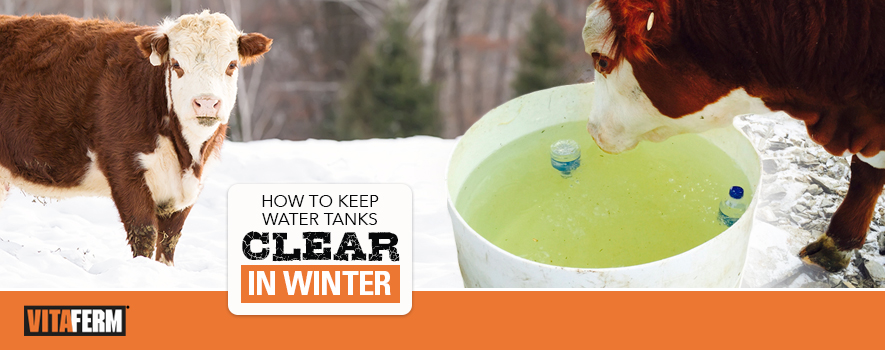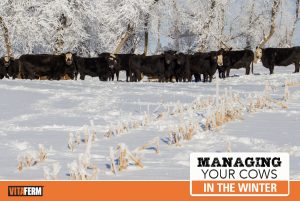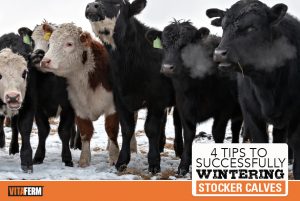
Cold weather and water never make for a good combination. You may have seen pictures floating around the internet of salt water bottles in water tanks to help keep them from freezing completely over. The idea is that even if the tank forms a layer of ice on it, your cattle could push the bottle down allowing access to water.
We all know that water is the most important nutrient, and access to good quality water is important. Daily intake on a cow can vary from 3 to 30 gallons per day depending on size, stage of production and environment. Dr. Rick Rasby, University of Nebraska, says “As a rule of thumb, consumption will range from 1 gallon per 100 pounds of body weight during cold weather to nearly 2 gallons per 100 pounds during the hottest weather.”
Allison May, VitaFerm Dealer and livestock producer from Pennsylvania, has been fighting frozen water tanks all winter. When she saw the clever idea of putting pop bottles containing salt water into small tanks to keep them from freezing solid she figured it was worth a shot. Here’s Allison’s account of the experiment.
Day 1: Set-Up
Phase one of the salt water bottle testing complete! I totally de-iced two large plastic water tanks and put two bottles with the salt water mixture in each of them around noon. Tonight there wasn’t even a thin layer of ice in them! I did a third tank, but it wasn’t totally de-iced when I put the salt water bottle in, and it had a layer of ice by dinner time.
Winter is when your cow is doing her hardest work. DON’T LET HER DOWN! It’s protein time as proper protein supplementation is essential to overall animal productivity and performance that pays! All VitaFerm® Concept•Aid® protein products provide the convenience of Concept•Aid along with a natural protein source so there is no need for additional vitamin and mineral fortification when forage quality is low.

Day 2: Results
I give the salt water bottle method one thumbs up and one thumbs down. This is what happened after one night of single digit and below temperatures.
1. The metal buckets were still frozen.
2. The plastic buckets were less frozen than the metal buckets.
3. Buckets without the water bottles had 2-3 inches of ice on top.
4. Buckets with the water bottles only had maybe 1/2 inch of ice on top, with air underneath, and really thin ice around the bottles.
5. None of the cows plowed me over for water like they usually do in the mornings.
6. The salt water bottles were still unfrozen.
Summary
It appears as though the bottles allowed the cows access to the water through most of the night, but didn’t totally prevent bucket freezing. Also, even on the plastic tanks that froze over there was significantly less ice, which make it easier to break up in the morning. Alternatively, milk jugs might work a little better because they would create a larger gap in the ice. I will probably continue to keep the salt water bottle in our buckets and tanks.
– Allison May, Breakthrough Livestock Services
Remember if you are having a hard time getting your livestock to drink or eat, consider giving them a dose of one of our Vita Charge products to jump start the digestive system and stimulate intake.



